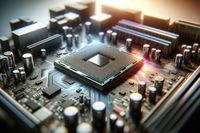NVIDIA Accelerates Quantum Computing Exploration at Australia’s Pawsey Supercomputing Centre
Scientists to Run State-of-the-Art Quantum Computing Simulations Using NVIDIA CUDA Quantum Platform, Turbocharged by NVIDIA Grace Hopper Superchips

NVIDIA and Pawsey Supercomputing Centre Collaborate on Quantum Computing
NVIDIA has announced a collaboration with Australia’s Pawsey Supercomputing Research Centre to accelerate quantum computing research. As part of the collaboration, Pawsey will integrate the NVIDIA CUDA Quantum platform with the NVIDIA Grace Hopper Superchips into its National Supercomputing and Quantum Computing Innovation Hub. The CUDA Quantum platform offers powerful simulation tools and capabilities to program hybrid CPU, GPU, and QPU systems. It will be used alongside the NVIDIA cuQuantum software development kit to accelerate quantum computing workflows.
Tim Costa, director of HPC and quantum computing at NVIDIA, highlighted the importance of high-performance simulation for breakthroughs in quantum computing. He stated that the combination of CUDA Quantum and the NVIDIA Grace Hopper Superchip will allow researchers at Pawsey to address challenges related to algorithm discovery, device design, error correction, and more. This collaboration will accelerate the timeline for useful quantum-integrated supercomputing.
Mark Stickells, executive director at the Pawsey Supercomputing Research Centre, praised the CUDA Quantum platform, stating that it will push the boundaries of quantum computing research and enable scientists to explore new possibilities.
The Future of Quantum Computing in Australia
Quantum computing has significant potential in Australia, and the collaboration between NVIDIA and Pawsey Supercomputing Centre aims to unlock that potential. According to CSIRO, the national science agency in Australia, the domestic market opportunity from quantum computing is estimated to be worth $2.5 billion annually with the potential to create 10,000 new jobs by 2040.
To achieve this, quantum computing needs to be embedded in other scientific domains such as astronomy, life sciences, medicine, and finance. Pawsey's deployment of the NVIDIA Grace Hopper Superchips will pave the way for advancements in quantum machine learning, chemistry simulations, image processing for radio astronomy, financial analysis, bioinformatics, and specialized quantum simulators.
Pawsey is committed to making the NVIDIA Grace Hopper platform available not only to the Australian quantum community but also to its international partners. By leveraging the power of NVIDIA's accelerated computing technologies, Pawsey aims to push the boundaries of quantum computing and drive scientific exploration.
NVIDIA Grace Hopper Superchips for Quantum Computing
Pawsey Supercomputing Centre will deploy eight NVIDIA Grace Hopper Superchip nodes based on NVIDIA MGX modular architecture. These superchips combine the NVIDIA Grace CPU and Hopper GPU architectures, providing extreme performance for high-fidelity and scalable quantum simulations. The nodes will use NVIDIA NVLink-C2C chip interconnects, increasing the bandwidth between the GPU and CPU by 7x compared to the latest PCIe technology.
With the NVIDIA Grace Hopper Superchips, Pawsey will be able to run quantum workloads directly from traditional high-performance computing systems. This will enable the development of hybrid algorithms that intelligently divide calculations into classical and quantum kernels, maximizing computing efficiency. The superchips will deliver up to 10x higher performance for applications running terabytes of data, empowering quantum-classical researchers to solve complex problems.



